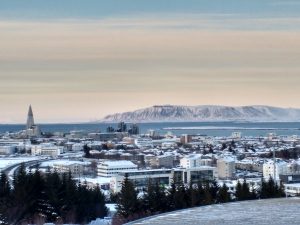Close to economic melt-down in 2009, Iceland is staging a remarkable come-back.
And on June 22nd, this nation of 300k reached the knock out stages of Euro 2016 in France. Forget all the financial computations on the level of improvement in the economy, this single event has done more to promote Iceland positively to the world as a place to do business with, and to visit than anything else possible could.
I was there in January 2016 to see the already remarkable strides Iceland has made in tourism, which I’m sure it will now extend. I wrote then that it had crafted a tourist boom out of a celestial light show, the Northern Lights, from outdoor bathing powered by volcanic heat, and an epic day trip into the lava wastes. This is my article.
Warm welcome
Iceland is so close (my Thomson Holidays flight took two and a half hours from Gatwick), so comfortable, yet so distinct. The old heart of Reykjavik feels like an easy-going small town. The air is clean and fresh, the streets are safe. And bright – houses, restaurants, factories, even churches, are clad in cheerful, colourful corrugated steel of many colours. There’s friendly service everywhere. Most Icelanders speak effortless, fluent English. Renewable energy, mainly free hot water, is abundant. The post-Recession recovery is spectacular, and some of its bankers actually went to prison. But my favourite thing is the famous Iceland jumper, both sharp fashion and a lifetime’s guarantee against the cold.
Capital tour
Take an bus tour of Reykjavik, although it’s small enough to do on foot, particularly in spring as the temperatures pick up – it was -7°C for our February trip. Down on the waters edge is the proud, new performance centre, Harpa, sparkling with multi-coloured glass panels. Fishing sustained this nation for a millennium; they tell the story in the Maritime Museum on the harbour’s edge. On permanent show is the principal weapon in the bitter Cod Wars with the UK in the 1970s, the patrol vessel Odinn, with its original fishing net-cutting gear like a device from a Bond film. Soaring about everything in this low-rise city is the tremendous, 220 feet high Hallgrímskirkja church. Its stepped wings like organ pipes recall the shapes cooling lava makes in Iceland’s landscape.
Golden Wonder
Winter or summer, the seven hour drive into Iceland’s raw and rugged interior, the Golden Circle, is irresistible. (And not only to tourists. Game of Thrones is filmed here.) We passed multiple snow-capped versions of Ayers Rock, often the backdrop to galloping Icelandic horses, and the notorious Eyjafjallajökull which caused such dusty chaos to aviation in 2010. Geyser is a broody, simmering place, spot on for the witches scene in Macbeth, enlivened by Strokkur’s steamy eruption every ten minutes. Next stop is the thunderous waterfall at Gullfoss, where cheerful staff serve sustaining meat soup and cake. Last call is the site of the original parliament, Thingvellir. surely the most tranquil, and beautiful, place for politics on the planet. This rift valley is a site of geological drama. Tectonic plates are drifting apart at an inch a year.
Lights fantastic
The Northern Lights (Aurora Borealis) is the greatest, non-destructive, natural show on Earth. Iceland, with the Arctic Circle cutting through the top third, is one of the best places to see it. Our driver took us out of town, where light pollution is low. The display had already started, a pale green band stretched across the starry sky, pulsing and rippling at random. A true wonder of the world. And this was only stage one, out of four. Other nights lucky people might see the full-colour, all dancing display, caused by electrical discharges from the sun colliding with particles in our atmosphere. Sightings aren’t guaranteed, but can be forecast about four days out. September to mid-April are the best times.
Rhapsody in Blue
Iceland offers a unique comfort, the chance to bask in the balmy 36° C heat of free hot water coursing up from volcanic depths. It’s welcome at any time, but especially on winter days of nipping cold. There are many public pools with natural geothermal water in Iceland, but the swanky Blue Lagoon, midway between Reykjavik and the main airport, and expanded in 2016, is the biggest, with the best facilities. There’s even a waterside bar. Nobody swims. You wallow in the outdoor pools, or stand decadently around in the steamy fog with a drink in hand, posing for (preerably waterproof) cameras at this popular backdrop for fashion shoots. For a sybaritic extra, try a massage, lounging back in the water on a supportive mat. www.bluelagoon.com.
Cosy stay
I stayed in the neat and new (late 2015) Storm Hotel, all soft wood and light-touch Nordic detail. Just off the city centre and waterfront, it is an ideal base for a winter visit. As for restaurants and bars, it is a rare thrill on returning to a place after many years, to find a favourite place still open. Kaffivagnin, down on the old harbour edge, once again served me exceptional fish and chips. I also recommend Old Iceland, and for special occasions Kolabrautin Ristorante, atop the Harpa concert hall. There’s a big choice of cosy bars, but rather than expensive imported wine, try local craft beer – the cosy Bjórgarðurinn has a huge range. Or delicious tap water, served in big clear bottles. It is some of the world’s purest.
I was a guest of Thomson Holidays. Its winter packages resume in November 2016, flying from Gatwick and Manchester. www.thomson.co.uk www.visiticeland.com

